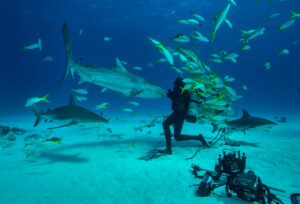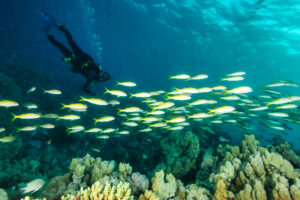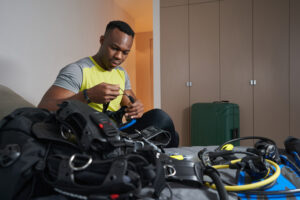What is No Mount Diving?
No mount diving is a specialized form of scuba diving that involves the diver carrying tanks and equipment separately from their body, usually holding or towing them instead of mounting them on a harness or backplate. This technique provides exceptional flexibility and maneuverability, particularly in environments that are too restrictive for traditional scuba gear setups. Originating from the need to navigate through tight underwater spaces, no mount diving has become a valuable technique in underwater exploration and technical diving circles, especially among cave divers and those exploring complex underwater structures.
Historical Development
The concept of no mount diving emerged as an innovative solution to the challenges faced by divers in extremely confined spaces. Traditional scuba gear, while highly effective in open water, often proved cumbersome in narrow underwater passages. Early adopters of no mount diving were primarily cave explorers who needed to traverse tight restrictions that standard equipment could not pass through. In the 1980s and 1990s, the practice began to gain more attention as divers pushed the boundaries of underwater exploration.
Pioneers such as Sheck Exley and other cave diving legends played significant roles in the development and refinement of no mount techniques. These early practitioners often had to modify existing equipment or create new gear to suit their needs, leading to a culture of innovation within the diving community. As the practice grew, it began to influence equipment manufacturers, who started producing gear specifically designed for no mount diving.
The evolution of no mount diving continued into the 21st century, with advances in technology and materials making the practice more accessible and safer. Training programs and certifications emerged, formalizing the techniques and safety protocols associated with no mount diving. Today, it is recognized as a distinct discipline within the broader field of technical diving, with a dedicated following of enthusiasts and professionals.
Equipment and Gear
No mount diving requires a unique set of equipment tailored to the needs of divers operating in confined spaces. The most significant difference from traditional scuba gear is the handling of tanks. Instead of being strapped to the diver’s back, tanks are carried in the diver’s hands, clipped to a harness, or towed behind. This configuration allows the diver to maneuver through tight passages that would be impossible to navigate with back-mounted tanks.
The tanks used in no mount diving are typically smaller and more streamlined, allowing for easier handling and less drag. Divers often use aluminum tanks because they are lighter than steel, making them easier to manage. Additionally, specialized regulators and hoses are used to facilitate the unique positioning of the tanks and ensure a reliable supply of air.
Harnesses and buoyancy control devices (BCDs) are also adapted for no mount diving. These components are designed to provide maximum flexibility and minimal bulk, often incorporating quick-release mechanisms for easy detachment of tanks. Some divers use minimalist harness systems that eliminate the traditional backplate altogether, relying instead on webbing and clips to secure their equipment.
Another critical aspect of no mount diving gear is lighting. Given the environments in which no mount diving typically occurs—such as caves and shipwrecks—powerful and reliable lighting systems are essential. Divers use primary and backup lights mounted on helmets or handheld, ensuring they can navigate and communicate effectively in complete darkness.
Techniques and Training
Mastering no mount diving requires a thorough understanding of specialized techniques and rigorous training. Unlike traditional scuba diving, no mount diving demands a higher level of precision and control due to the challenges of managing multiple tanks and operating in confined spaces. Training programs focus on developing these skills, starting with basic techniques and progressing to more advanced maneuvers.
One of the fundamental skills in no mount diving is proper tank handling. Divers must learn to manage their tanks efficiently, ensuring they can be moved smoothly and securely in tight passages. This involves practicing various methods of clipping and unclipping tanks, as well as techniques for passing tanks through restrictions ahead of the diver.
Buoyancy control is another critical area of training. No mount divers need to maintain precise buoyancy to avoid damaging delicate underwater environments and to ensure their own safety. This requires advanced finning techniques and the ability to make fine adjustments to buoyancy using breath control and the BCD.
Safety is a paramount concern in no mount diving, and training programs emphasize the importance of redundancy and preparedness. Divers are taught to carry multiple backup systems for air supply, lighting, and navigation. They also learn emergency procedures, such as how to handle equipment failures and how to exit confined spaces quickly in the event of a problem.
Certification programs for no mount diving are offered by various diving organizations, each with its own standards and requirements. These programs typically include classroom instruction, pool training, and open water dives, ensuring that divers are well-prepared for the challenges they will face in no mount diving environments.
Applications of No Mount Diving
No mount diving is particularly suited to environments where traditional scuba gear is impractical or impossible to use. One of the primary applications of no mount diving is cave exploration. Caves often feature narrow passages and tight restrictions that require the flexibility and maneuverability provided by no mount diving techniques. This allows divers to penetrate deeper into cave systems and discover areas that would otherwise be inaccessible.
Scientific research is another area where no mount diving is highly valuable. Researchers studying underwater ecosystems, geology, and archaeology often work in confined spaces such as submerged caves, wrecks, and tunnels. No mount diving enables them to reach these areas and conduct their work more effectively. For example, marine biologists can access hard-to-reach habitats to collect samples and observe species in their natural environments.
Rescue and recovery missions also benefit from no mount diving techniques. In underwater rescue scenarios, the ability to maneuver through tight spaces can be crucial for reaching trapped individuals and providing assistance. No mount divers can navigate collapsed structures and debris fields more effectively than divers using traditional gear, making them invaluable in emergency situations.
Additionally, no mount diving has applications in commercial diving operations. Tasks such as underwater inspections, repairs, and maintenance often require divers to work in confined spaces such as pipelines, storage tanks, and ship compartments. No mount diving allows these divers to access and operate within these environments more efficiently.
Risks and Challenges
No mount diving presents a unique set of risks and challenges that divers must be prepared to manage. One of the primary risks is the potential for entanglement or entrapment in confined spaces. The diver’s increased freedom of movement also comes with the increased possibility of getting caught on protrusions or entangled in debris. Divers must be highly skilled in managing their equipment and aware of their surroundings at all times to mitigate this risk.
Another significant challenge is the increased physical and mental demand of no mount diving. Managing multiple tanks and other gear while navigating through tight passages requires a high level of physical fitness and mental acuity. Divers must be prepared for the physical strain of carrying and manipulating their equipment in confined spaces, as well as the psychological stress of operating in environments where escape routes may be limited.
Breathing gas management is a critical concern in no mount diving. The use of multiple tanks requires careful planning and monitoring to ensure an adequate supply of breathing gas throughout the dive. Divers must be proficient in gas switching techniques and aware of their consumption rates to avoid running out of air in critical situations.
Visibility is often limited in the environments where no mount diving takes place. In caves, wrecks, and other confined spaces, silt and debris can quickly obscure visibility, making navigation and communication more difficult. Divers rely on powerful lighting systems and line markers to find their way, but they must also be prepared for the possibility of losing visibility and needing to navigate by touch.
Finally, the risk of equipment failure is heightened in no mount diving due to the complex and specialized nature of the gear. Divers must carry redundant systems and be proficient in troubleshooting and repairing equipment underwater. Regular maintenance and thorough pre-dive checks are essential to minimize the risk of equipment issues during a no mount dive.
Notable Expeditions and Discoveries
No mount diving has enabled numerous significant expeditions and discoveries in underwater exploration. One notable example is the exploration of the Blue Hole in Dahab, Egypt, a popular but challenging dive site with a notorious reputation for its depth and the treacherous archway at approximately 56 meters (183.7 feet). No mount divers have been able to navigate the narrow passages within the Blue Hole, contributing valuable data on its geology and underwater conditions.
In the field of underwater archaeology, no mount diving has been instrumental in the exploration of submerged ruins and shipwrecks. For instance, the discovery and investigation of ancient shipwrecks in the Mediterranean Sea have been facilitated by no mount techniques. Divers can access and document these underwater sites, providing insights into historical trade routes and maritime cultures.
Scientific research has also benefited from no mount diving, particularly in the study of submerged cave systems. In Mexico’s Yucatán Peninsula, no mount divers have explored the extensive network of cenotes and underwater caves, uncovering important paleontological and archaeological finds. These explorations have revealed well-preserved remains of prehistoric animals and early human artifacts, offering a glimpse into the region’s ancient past.
No mount diving has also played a crucial role in rescue and recovery missions. The 2018 Tham Luang cave rescue in Thailand is a prominent example where no mount diving techniques were employed to navigate the narrow, flooded passages and rescue the trapped soccer team and their coach. The success of this mission highlighted the importance of no mount diving skills and equipment in challenging and high-risk environments.
Key Takeaways
No mount diving represents a specialized and highly skilled aspect of scuba diving, offering unparalleled access to confined and challenging underwater environments. Its development and application have been driven by the needs of explorers, scientists, and rescuers to navigate spaces that traditional scuba equipment cannot. With a unique set of techniques and gear, no mount diving continues to push the boundaries of underwater exploration, contributing to significant discoveries and enhancing the capabilities of divers in various fields.

















